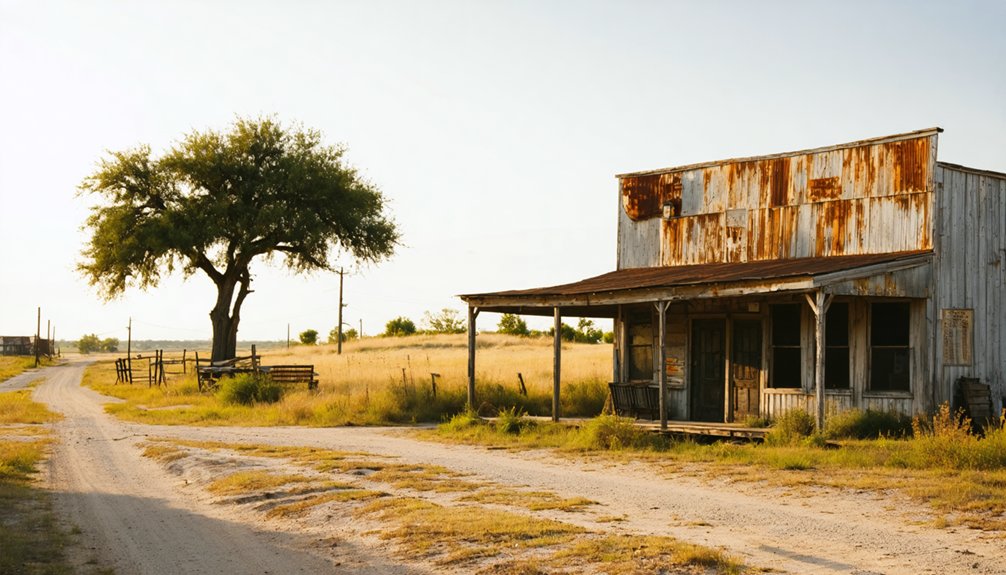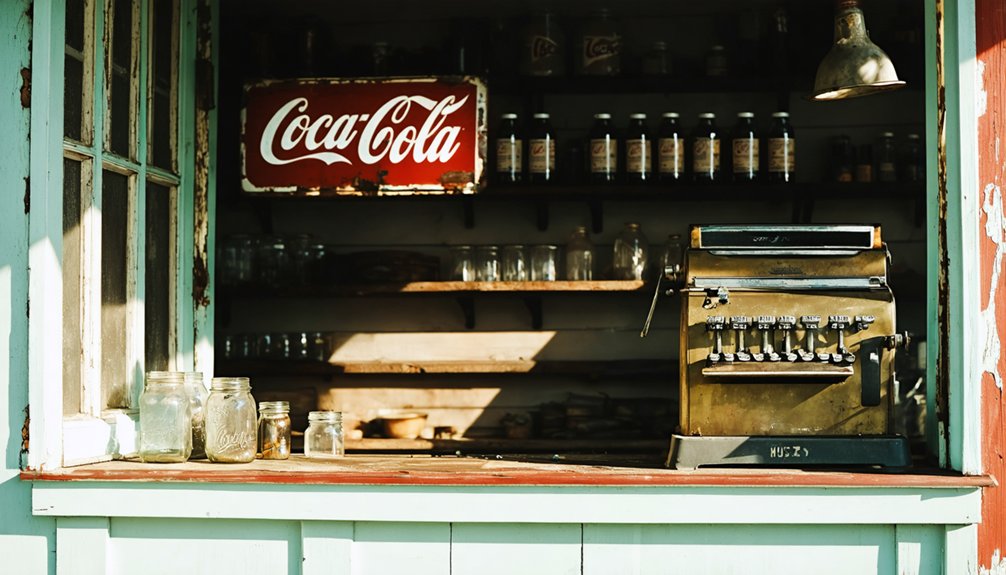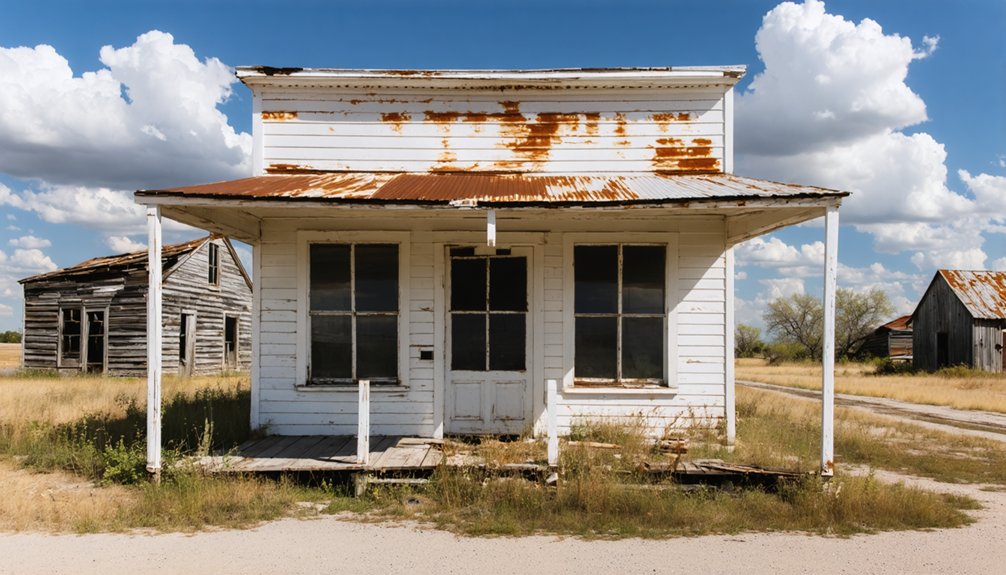You’ll find Lytton Springs in northern Caldwell County, Texas, established in 1845 by John and Sarah Litton along with Michael Young and Sarah’s brothers. Originally named Young’s Settlement, then Perryville, the community earned its nickname “Hogeye” from a popular fiddle tune. The historic springs, Litton’s homestead, and the 1859 General Store marked this frontier settlement’s heyday. Today’s quiet streets and preserved structures tell a rich story of Texas frontier life.
Key Takeaways
- Originally established in 1845 as Young’s Settlement, Lytton Springs evolved through multiple name changes before becoming a ghost town.
- The Lytton Springs General Store, founded in 1859, served as the community’s primary commercial hub before the town’s decline.
- The town’s population has transitioned from a bustling settlement to a sparse density of 82 people per square mile.
- Historical preservation efforts focus on iconic structures like the Tabernacle and General Store to maintain the ghost town’s cultural heritage.
- The community’s ghost status reflects its evolution from an active settler outpost to a historically significant but sparsely populated area.
The Birth of a Texas Settlement
When John and Sarah Litton joined forces with Michael Young and Sarah’s brothers in 1845, they established what would become known as Young’s Settlement, later called Perryville.
The settlement dynamics centered around Litton’s homestead, which served dual purposes as both the Concord Stage Line station and the area’s first post office, with John Litton appointed postmaster by President Zachary Taylor in 1849.
Litton’s homestead became the heart of early Perryville, housing both the stage line station and post office by 1849.
The community establishment took root on land originally granted to Elizabeth Standifer in Stephen F. Austin’s “Little Colony” in 1829.
You’ll find the Littons settled northeast of the main settlement on Little Sandy Creek, where John built the region’s first house made entirely of sawed lumber.
The name Perryville gained traction among local churches and the Masonic lodge, honoring Michael Young’s son Perry.
Their homestead became a vibrant gathering spot where locals enjoyed dances and events throughout the year.
John’s military service during the Texas Revolution helped secure land grants in multiple counties including Williamson, Bell, Lampasas, and Bastrop.
From Albade to Lytton Springs
You’ll discover that the Lytton Springs area underwent multiple name changes during its early development, shifting from Young’s Settlement to Perryville, with some locals using the nickname “Hogeye” after a popular fiddle tune.
During the devastating 1918-1920 pandemic that saw severe mortality rates, the remote location of Lytton Springs helped limit the spread of influenza among its residents.
The settlement’s evolution continued as the Litton family established themselves at the headwaters of Little Sandy Creek, building the region’s first sawed-lumber house and operating a vital stagecoach station. Today, the area’s educational needs are served by the Lockhart Independent School District.
The community ultimately consolidated under the name Lytton Springs, reflecting both the prominent Litton family’s influence and the natural springs that characterized the landscape.
Origins Behind Name Changes
During the 1850s, the small Texas community known as Albade underwent a significant name transformation to become Lytton Springs, reflecting the growing influence of John Litton and his family in the region.
You’ll find the name significance deeply rooted in Litton’s role as the area’s first postmaster, appointed by President Zachary Taylor in 1849.
The community’s identity evolved through several names, including Young’s Settlement and Perryville, before settling on Lytton Springs.
The springs themselves, where Litton grazed his cattle in the 1840s, became central to the area’s identity. This location’s history is now preserved through community contributions that help maintain records of early Texas settlements.
The Litton home’s strategic position as both a Concord Stagecoach stop and post office solidified the family’s legacy in the community’s final naming.
Early Settlement Patterns
The story of Lytton Springs‘ early settlement stretches back to Native American tribes and Spanish explorers who first traversed the Texas landscape in the 1500s.
You’ll find the real settlement patterns began taking shape when Stephen F. Austin implemented his father’s colonization plans in 1821, bringing Anglo settlers under Mexican oversight. Like other settlers of the era, new residents were required to practice Christianity and pledge loyalty to Mexican authorities.
Early families like the Littons and Youngs established themselves in the 1840s, drawn by abundant springs and fertile land. They’d create Young’s Settlement, later known as Perryville, which became a crucial stagecoach station and post office.
John Litton, appointed postmaster in 1849, discovered the spring that would define the area’s future. The settlement patterns evolved from scattered homesteads to an organized community, with families building permanent homes using sawed lumber rather than frontier rough-cuts.
Life Around the Historic Springs
The springs you’ll find at Lytton Springs served as an essential water source for early settlers in Stephen F. Austin’s “Little Colony” from 1829 onwards.
You can trace the site’s history to a settler named Litton, who built a hunting platform near the ever-flowing spring to catch deer.
The spring’s reputation for attracting particularly tasty venison became part of local lore, with multiple historical accounts confirming the quality of deer harvested there.
Today, treasure hunters use historical maps from 1896 to locate promising metal detecting sites around the former settlement.
Like many historic Texas sites including Texana and Indianola, the original settlement’s prominence gradually faded into obscurity.
Early Settlers’ Water Source
Life-sustaining Lytton Springs served as an essential water source for pioneering settlers in southern Caldwell County, Texas during the mid-1800s.
The spring water, prized for its clarity and purity, became a critical survival resource that shaped early settlement patterns. You’d find settlers developing small ponds and reservoirs to maintain consistent access to this precious water supply. Like the first irrigation ditches established by Spanish settlers in 1718, these water management systems helped sustain the growing community. Unlike nearby oil wells that showed minimal water presence, the springs provided abundant water for the region’s development.
- Spring water powered local gristmills, enhancing the area’s economic growth
- Settlers paid by the bucket to haul fresh spring water to homes and merchants
- The springs’ reliable flow contrasted with seasonal creeks, making it invaluable for daily life
John Litton recognized the springs’ importance when he established cattle grazing lands nearby in the 1840s, following paths that Native Americans and early explorers like Espinosa had used since 1709.
Deer Hunting Platform Legacy
During early settlement of Lytton Springs, pioneering hunters constructed elevated platforms above the natural springs to observe and harvest the region’s abundant deer population.
These strategic perches let you spot deer as they came to drink, reflecting hunting traditions passed down through generations of Texas settlers.
You’ll find these platforms weren’t just about successful hunts – they played an essential role in maintaining ecological balance.
By enabling selective harvesting rather than random hunting, they helped early settlers manage deer populations sustainably.
Built from local timber, these elevated stands became important gathering spots where hunters shared knowledge about wildlife patterns and conservation practices.
The platforms represent how frontier communities adapted to their environment, balancing their need for sustenance with long-term wildlife preservation around Lytton Springs.
The Dancing Legacy of Hog-Eye
Rooted in the vibrant social fabric of rural Texas, Hog-Eye dancing emerged as a distinctive cultural tradition near Lytton Springs, blending Anglo-American, Mexican, and African American influences.
The Hog Eye influence spread throughout local gatherings, where dance community members stomped, clapped, and stepped to lively fiddle and accordion tunes. These celebrations became the heartbeat of rural life, fostering courtship and strengthening social bonds.
- Traditional movements incorporated agrarian themes, symbolizing planting and harvesting
- Dance circles and reels welcomed participants of all ages and social classes
- Annual festivals and modern adaptations keep the tradition alive through demonstrations
Today, you’ll find this legacy preserved through local East Texas cultural events, where historical societies work to protect this symbol of rural resilience and heritage.
Geography and Climate

Nestled in northern Caldwell County, Texas, Lytton Springs occupies a distinctive position at latitude 30.0047° N and longitude -97.6125° W, approximately ten miles northeast of Lockhart along Farm Road 1854.
You’ll find this ghost town amidst the gently rolling hills of Texas Hill Country, where natural springs have influenced land use patterns since the 1700s.
The area’s humid subtropical climate delivers hot summers exceeding 90°F and mild winters.
You’ll experience seasonal patterns typical of Central Texas, with 30-35 inches of annual rainfall concentrated in spring and fall.
The perennial water sources from the springs have historically supported diverse ecosystems and agricultural development, while the fertile soil and moderate elevation made it ideal for ranching and farming activities that shaped the region’s character.
Educational Growth Through Time
While formal records remain sparse, education in Lytton Springs initially centered around the community’s Tabernacle, built before 1912, which served as a multifunctional gathering space. Community gatherings and informal education flourished through week-long camp meetings that combined religious instruction, music, and social activities.
- Early education relied heavily on home-based and church-affiliated learning, with families like the McCandless and Perry contributing to children’s upbringing.
- As the settlement grew, formal schooling emerged following rural Texas patterns, focusing on basic literacy and numeracy.
- The shift to ghost town status led to school consolidation with nearby towns, though the Tabernacle Restoration Project continues to preserve the area’s educational heritage.
The educational legacy of Lytton Springs reflects the resilient spirit of rural Texas communities that valued learning within their social fabric.
The Iconic General Store

Since its founding in 1859, the Lytton Springs General Store has served as both a commercial hub and social cornerstone of the community.
You’ll find this architectural heritage preserved in its mid-19th-century construction, complete with an authentic wood-burning stove that still warms visitors during winter months.
The building’s rich history includes serving as a post office, stagecoach stop, and pre-Prohibition bar where ghost stories of colorful characters still linger.
Inside, you’ll discover historical artifacts and photographs that chronicle the area’s frontier past.
Step back in time as vintage photographs and frontier relics tell the story of Texas’ untamed yesteryears.
Located at the crossroads between Houston and San Antonio, this multipurpose establishment wasn’t just a store – it was a lifeline for travelers and locals alike, providing essential goods transported by ox-teams through Texas’ rugged terrain.
Pop Culture and Media Spotlight
Through its appearances in popular media, Lytton Springs has captured widespread attention, most prominently when its historic general store was featured in the television series *The Walking Dead*.
The media influence has transformed this quiet Texas community into a cultural destination, particularly for fans of post-apocalyptic storytelling and ghost town enthusiasts.
The town’s cultural significance extends through various creative mediums:
- Photography enthusiasts share striking images of the general store and abandoned structures across social media platforms.
- Folk musicians preserve local legends through traditional songs like “Hog-Eye,” connecting the town to Texas musical heritage.
- Historical narratives and ghost town blogs document the community’s evolution from settler outpost to atmospheric filming location.
The combination of television exposure and digital preservation has secured Lytton Springs’ place in contemporary pop culture.
Modern Community Life

Despite its ghost town status, you’ll find Lytton Springs maintains a vibrant community identity through its 7,092 residents and historic general store that continues serving locals.
The town’s educational landscape has evolved with the opening of Alma Brewer Strawn Elementary, serving a largely young population with a median age of 34.1 years.
While the area’s 11.38% college graduation rate suggests room for academic growth, the high public school enrollment rate of over 90% demonstrates the community’s ongoing commitment to education.
Educational Growth Continues
As Lytton Springs evolves from a rural settlement into a growing community of 6,000 residents, educational infrastructure has become a pressing focus for development.
New master-planned communities prioritize educational access through strategic placement near schools and learning resources. Local educational initiatives and community partnerships aim to enhance learning opportunities while promoting safe routes to schools.
- You’ll find growing demand for expanded educational facilities driven by the influx of new families in approximately 5,000 new homes.
- Your children can benefit from integrated community spaces and trails that encourage outdoor learning and active lifestyles.
- You’ll see potential for increased local control over educational planning and funding once incorporation status is achieved.
Future incorporation could empower residents to directly influence educational development aligned with community growth and values.
Historic Store Remains Active
While modern education shapes Lytton Springs’ future, the historic general store stands as a living tribute to its past.
You’ll find this remarkable 1859 establishment still serving the community’s daily needs, complete with its original historic architecture including a functioning wood-burning stove. The store’s enduring presence defies the typical ghost town narrative, acting as a vibrant hub for community gatherings and local commerce.
You can experience both history and modern convenience here, as the store maintains its traditional character while adapting to serve today’s customers.
Beyond its retail function, the store’s fame has grown through its appearance in “The Walking Dead,” attracting visitors from around the country.
This cultural landmark continues to preserve Lytton Springs’ heritage while fostering contemporary connections among residents and tourists alike.
Population Maintains Local Identity
Today’s Lytton Springs maintains a distinct small-town identity with its population of 7,092 residents spread across a sparse 82 people per square mile.
You’ll find a tight-knit community where cultural traditions thrive, shaped by both rural Texas roots and Austin metro influences. The average household size of 3.11 people reinforces strong family bonds and community cohesion.
- Local schools, especially the new Alma Brewer Strawn Elementary, serve as anchors for community gatherings and social connections.
- Housing affordability (median value $119,400) attracts working-class families who value independence and small-town atmosphere.
- Despite commuting challenges, residents maintain their unique unincorporated identity through informal social networks and shared local customs.
The area’s B- crime rating and B+ education scores reflect a community that’s preserved its character while adapting to modern needs.
Historical Preservation Efforts
Despite its ghost town status, Lytton Springs maintains an active historical preservation program through dedicated community organizations and local volunteers.
You’ll find preservation efforts focused on iconic structures like the pre-1912 Tabernacle and the 1859 General Store, which remain operational through careful restoration work. The Lytton Springs Park Association and Tabernacle Restoration Project spearhead these initiatives, though they face ongoing preservation challenges as an unincorporated area.
Community engagement thrives through genealogical societies, storytelling events, and traditional camp meetings at the Tabernacle.
The historic Tabernacle remains a vibrant gathering place, hosting everything from family history meetings to cherished camp meeting traditions.
While natural disasters and limited documentation pose risks to preservation, you can explore the town’s rich history through archived photographs, oral histories, and official recognition in the Texas State Historical Association’s records.
Local families continue contributing their personal histories to maintain this cultural legacy.
Frequently Asked Questions
What Indigenous Tribes Originally Inhabited the Lytton Springs Area?
For countless generations, you’d find the mighty Tonkawa people dominating tribal history here, though they shared the area’s cultural significance with Apache and Comanche tribes through migration patterns.
Are There Any Documented Paranormal Activities at the Historic General Store?
You won’t find documented ghostly encounters or spectral sightings at the historic general store – research shows no verified paranormal activity, despite the building’s age and role as a community hub.
What Is the Average Property Value in Lytton Springs Today?
With land costing about $21,104 per acre, you’ll find residential property values averaging $335,000-$395,000 in today’s market. Real estate trends show prices below Austin’s metro, keeping property taxes relatively manageable.
Does Lytton Springs Experience Any Significant Seasonal Flooding or Natural Disasters?
You’ll face significant flooding risks due to seasonal rainfall patterns and proximity to the Guadalupe River basin. Historical flood records from 1869-2015 show recurring threats during spring and early summer months.
Which Famous Historical Figures Have Passed Through or Visited Lytton Springs?
Like footprints in time, you’ll find Stephen F. Austin’s influence here, but few famous visitors are documented. John Litton and Elizabeth Standifer’s historical significance stems from their early settlement rather than celebrity status.
References
- http://sites.rootsweb.com/~lyttonsprings/Hist_Lyttongrp.html
- https://en.wikipedia.org/wiki/List_of_ghost_towns_in_Texas
- https://en.wikipedia.org/wiki/Lytton_Springs
- https://www.atlasobscura.com/places/lytton-springs-general-store
- https://www.tshaonline.org/handbook/entries/lytton-springs
- https://www.tshaonline.org/handbook/entries/lytton-springs-tx
- https://gov.texas.gov/film/trail/fear-the-walking-dead-trail
- https://sites.rootsweb.com/~deschart/z0001396.html
- http://toddshistory.com/?cat=15
- https://pubs.geoscienceworld.org/aapg/aapgbull/article/10/10/953/544288/The-Lytton-Springs-Oil-Field-Caldwell-County



